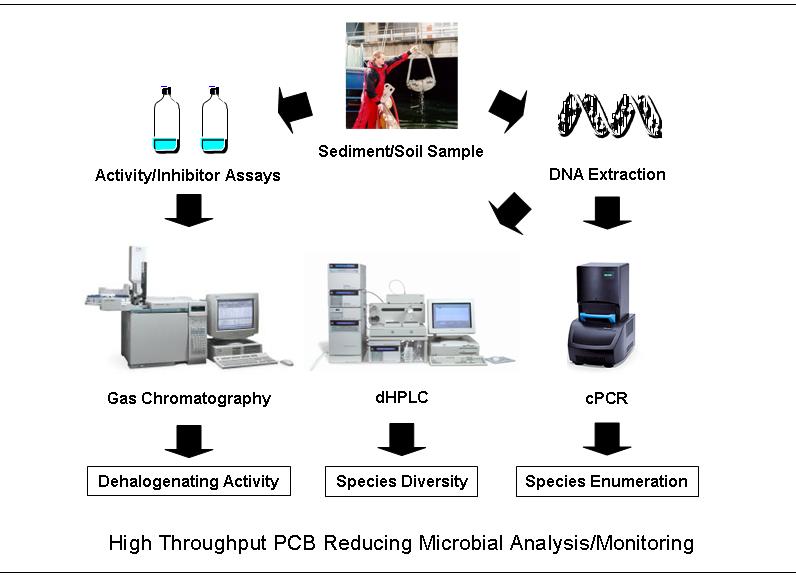|
|
Biology of Methanogenesis |
Department of Marine Biotechnology UMBC - Institute of Marine & Environmental Technology
Quantifying Enhanced
Microbial Dehalogenation Impacting the Fate and Transport of Organohalide
Mixtures in Contaminated Sediments

Development of sediment amendments for contaminant
in-situ degradation is a high priority for DoD. Techniques are needed to stimulate microbial dehalogenation of organohalide mixtures, including polychlorinated biphenyls (PCBs), chlorinated pesticides (CPs), and polychlorinated dibenzo-p-dioxins and furans (PCDD/Fs). Development of in situ amendments for enhancing dehalogenation of mixtures, refinement and in situ testing of tools and methods for monitoring the effectiveness of amendment placement and mixing, and development of model frameworks to track contaminant fate and transport during in situ biostimulation are crucial for the successful management of contaminated sediments.The overall objectives
are to extend techniques and amendments that enhance microbial dehalogenation for placement in sediments contaminated with organohalide mixtures, including PCBs, PCDD/Fs and CPs and to develop methods and tools to monitor the effectiveness of the biostimulation process. The specific project tasks are to 1) Develop sensitive complementary molecular methods to quantify and monitor the progress of site-specific indigenous or bioaugmented dehalogenating activity; 2) Characterize the effect of sedimentary conditions on the (bio)transformation rates of organohalide mixtures and their transformation products under various bioremediation scenarios; 3) Apply combined techniques to accelerate dehalogenation including chemical co-amendments, bioaugmentation and capping (active and inactive) to optimize remediation/detoxification and minimize environmental impacts; and 4) Evaluate the fate and transport of organohalide contaminants, co-amendments and (bio)transformation products under various bioremediation scenarios. Studies will be carried out at the microcosm and mesocosm scale resulting in a pilot scale field demonstration.Our research will complement and integrate with other ongoing activities related to remediation of marine and estuarine sediments (e.g., capping) by developing techniques for stimulating
in situ bioremediation, site characterization methods to measure the activity of dehalogenating bacteria in situ, and assessing the partitioning and transport of organohalide contaminants and biotransformation products. Collaborators
Collaborators
Lee Kerkhof, Rutgers University, Inst. of Marine and Coastal Sciences
Donna Fennell, Rutgers University, Dept. of Environmental Science
LisaTotten, Rutgers, Dept. of Environmental Science
 Project Team
Project Team
Courtney Naff
 Related Publications and Abstracts
Related Publications and Abstracts
Park J.W., Krumins V., Kjellerup B.V., Fennell D.E., Rodenburg L.A., Sowers K.R, Kerkhof L.J., Häggblom M.M. 2010. The effect of co-substrate activation on indigenous and bioaugmented PCB dechlorinating bacterial communities in sediment microcosms. Appl. Microbiol. Biotechnol. 89: 2005-2017 [ABSTRACT]
Kjellerup, B.V., X. Sun, U. Ghosh, H.D. May, K.R. Sowers. 2008. Site specific microbial communities in three PCB-impacted sediments are associated with different in situ dechlorinating activities Environ. Microbiol. 10: 1296-1309.
Park, J-W. , M. Haggblom, D. Fennell, L. Kerkhof, V. Krumins, K. Sowers, B. Kjellerup. Developing PCR-based molecular methods for quantifying and monitoring dechlorination of polychlorinated compounds ”. 108th Ann. Mtg. Amer. Soc. Microbiol. June 1-5, 2008. Boston, MA.
Häggblom, M.M., Donna E. Fennell, Lee J. Kerkhof, Lisa Totten, Kevin R. Sowers, Hui Liu, Fang Liu, Young-Beom Ahn, Joong-Wook Park, Valdis Krumins, Birthe V. Kjellerup and Meredith Wright. Quantifying Enhanced Microbial Dehalogenation of Organohalide Mixtures in Contaminated Sediments”. The Partners in Environmental Technology Technical Symposium a& Workshop. December 4 - 6, 2007. Washington, DC.
Funded by
